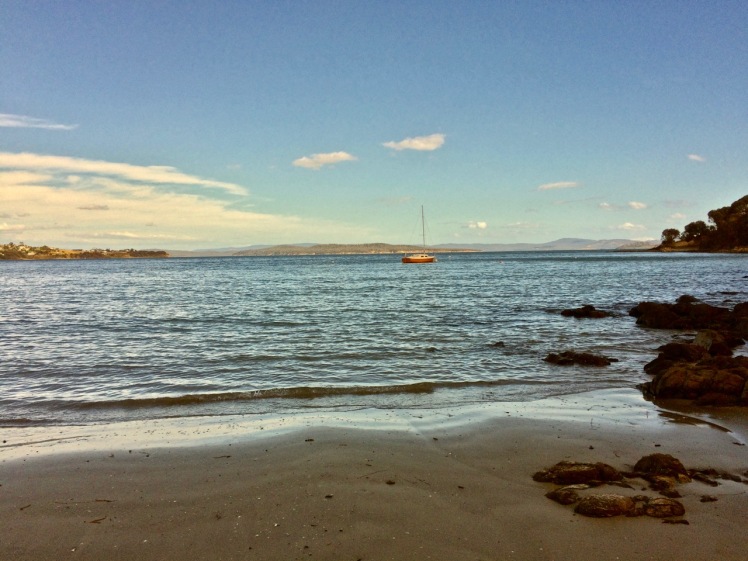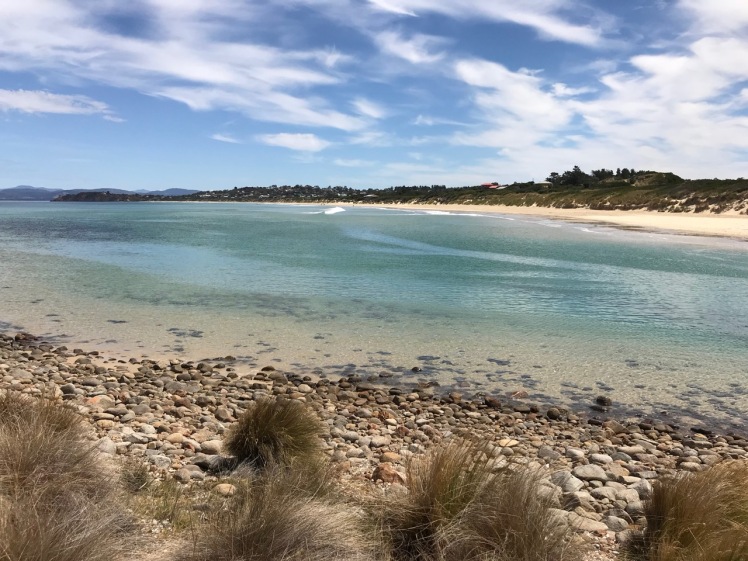Unexpectedly Rebuffed
From Carlton Beach the bluff had looked inviting. We were even sure we we could see a track, but from the beach at Primrose Sands it showed us a different face. There was a little bit of suburb on that side of the slope but not enough to domesticate it because although we explored all its roads, we found no access to a promising track.

It’s the norm in Hobart for suburbs to have tracks and trails through the bushland that backs or interweaves with them, but the Sorell Council seemed to have not yet done Primrose Sands this favour. Still, their lack of action protects the bluff and no doubt about it, the people who live there have millionaire views over Norfolk Bay and the Tasman Peninsula, Sloping Island and Frederick Henry Bay, as well as west towards Bruny Island. One day property here is going to boom, but on our visits it seemed as though everyone had evacuated. Later I read in The Mercury that the place has unfortunately been plagued by arson and there were depressing signs of this.
Carlton Bluff Take One
It was a perfect summer day when we first set off to meet the bluff, leaving our shoes behind us. This meant that when we reached the far end of the beach we couldn’t continue around the bluff by way of the rocks. A young mother and her badly mosquito bitten children were swimming in the sea. There was a house right there, just above the high tide mark and a light smattering of shells caught our attention. Offshore, a boat lay anchored. It was an invitation to dawdle and admire the almost 2 km stretch of beach between the bluff and Renard Point. It’s a moderately exposed beach. Short (2006) explains that the low waves this beach gets are refracted and work with the fine sand to shape and maintain cusps along its extent, as well as a low tide terrace.

We walked back passed undercut foredunes topped with marram grass and a male ray lying dead and mutilated on the sand. We stopped to talk to a local who assured us it was definitely possible to circumnavigate the bluff by way of the rocks on a good low tide.


We decided to come back another day and explore the rocks with our shoes on. We agreed that it would be a short and easy stroll with a bit of rock hopping, but I should have known by now that headlands present all sorts of challenges and it really doesn’t pay to underestimate them.
Carlton Bluff Take Two
When we returned a month later we noticed a plaque freshly glued into the rocks, a small memorial for a lost daughter and so we paused for a quiet moment. The tide was low but not low enough and having reached a point where we could see around the corner into cobbled bays with further rocky points beyond, we agreed we were unlikely to get any further around with our tiny four legged companion and so we called it quits.
Carlton Bluff Take Three
We three tried again some time later, exploring various roads beyond the dried out wetlands, climbing the urbanised stretch of the bluff in search of a path. We could find no access point so yet again we returned to the beach to tackle the rocks. We took off our shoes and rolled up our pants to get over a little gulch. We lifted Matisse up and set him down over those obstacles too vast for tiny poodle legs to manage, but pretty soon they were too great for us too. Sea urchin shells lay about quite densely at the point we reached. In fact, it looked like it could be a midden. Some boys in a boat were fishing and diving offshore. Everything looked serene but I was rueing the fact that we kept missing the better low tides.
Despite the pretty good conditions that day, it was Bluff 3 and us zero. And so decided to abandon our efforts and continue on our way around Renaud Point.
Carlton Bluff Take Four
On another day, further down the coast, we met a man of Dutch descent, who had lived in the area for thirty odd years. He told us that to walk Carlton Bluff you take the path between houses off Midden Street and so encouraged by this new information, we rushed off to try again.
It was 23 November 2017. Hobart was experiencing its longest stretch of continuous days over 27 degrees since records had started 140 years before. That day it was 29 degrees C, a day better suited for swimming than walking, because in Tasmania that sort of temperature is sharp and dry and can feel like needles boring into your skin.
We found the gap between the houses and followed it down to the banks of the Carlton River. In the stratigraphy of the river’s banks there were hints of meals consumed hundreds if not thousands of years ago. We also found an abandoned pair of thongs and several bits of plastic litter and the clear turquoise waters of the river were marred by blooms of what I took to be baggiota floating along the edges. Despite the brutal heat we felt a sense of achievement looking across the river to where we had walked some time before. This time, for sure, we were going to round that bluff.

Eventually we discovered a narrow path above us and clambered up the slope to reach it. Now that we had a path this would be a cinch, we thought, but pretty soon we chose to go back down to the rocks again because we wanted to enjoy the water and we figured that there less chance of encountering snakes down there. We could feel the heat coming up through the soles of our shoes in a most uncomfortable manner and the going was slow. At various points we had to clamber back up, seeking out the path again, picking our way through tussocks of marram and copses of casuarinas, in search of shade for small snatches of cool respite.
Mostly we were off a path rather than on it and the paths we found became confusing – they could well have been made by animals. Our definite preference was the rocks and we started taking every opportunity we could to take off our shoes and sit with our feet in the rock pools, marvelling at their health and the diversity of the seaweed, so different from the D’Entrecasteaux Channel where I’d been sailing and kayaking the week before, observing stressed reefs in the vicinity of the fish farms that I have come to hate for the damage they do to the natural environment and for the impaired lives of the fish entrapped in them.
We had not actually made it to the end of this side of the bluff when my friend remembered an arrangement she had made to see a movie – and so again we turned back.
Four to the Bluff, zero to us.
I still think it’s perfectly possible to walk around the bluff – two locals have said so – but if you plan to do it, start on Midden Road, stay true to the path, choose a cool day and allow ample time. As for kayaking the bluff (something else I considered) sharks enjoy loitering at river mouths, so maybe I will and maybe I won’t. And as for sailing it, that was on my to do list that last summer we owned Samos, but we ended up doing more boat maintenance than actually sailing – and an entirely different adventure was lying in wait.
It’s Getting Pretty Hot Down Here
Today, in Jan 2019 as I publish this post, the island is on fire. Wilderness has been consumed and houses lost. There is a ‘100 year deluge’ in Queensland and North America is experiencing record low temperatures. It’s becoming predictable for temperatures around the globe to break records, year after year, season after season.
And yet the faux president of the USA, whose connection to nature apparently extends no further than a golf course claims there is no climate change, a notion that was beginning to sound silly and uninformed back in the 1980s. His is the most stark, most shocking, most dangerous expression of wilful ignorance I believe I’ve ever heard. It illustrates the Great Disconnection that has placed our ecosystem at such dire risk.
On a small island like Tasmania multiple sizeable fires are an indication of how quickly the world as we know it can be irrevocably changed. The air that we breathe, the ground we walk on. The water we drink.
On a beach, a rock pool, deep and vibrant with life one week can be obliterated by sand the next as the beach replenishes itself.
You would not know, as you walk over it, that it had ever existed.